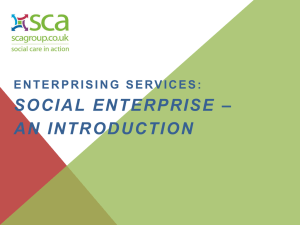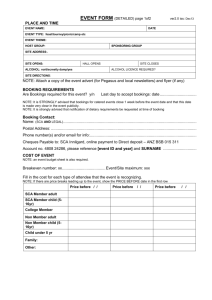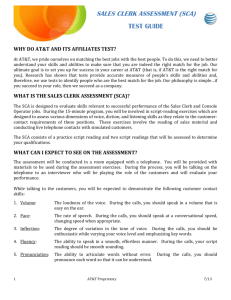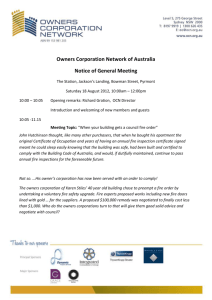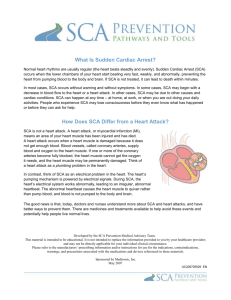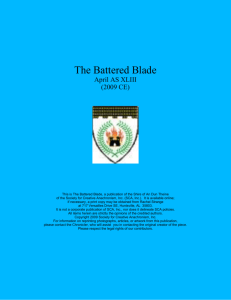SSAP No. 97 - National Association of Insurance Commissioners
advertisement
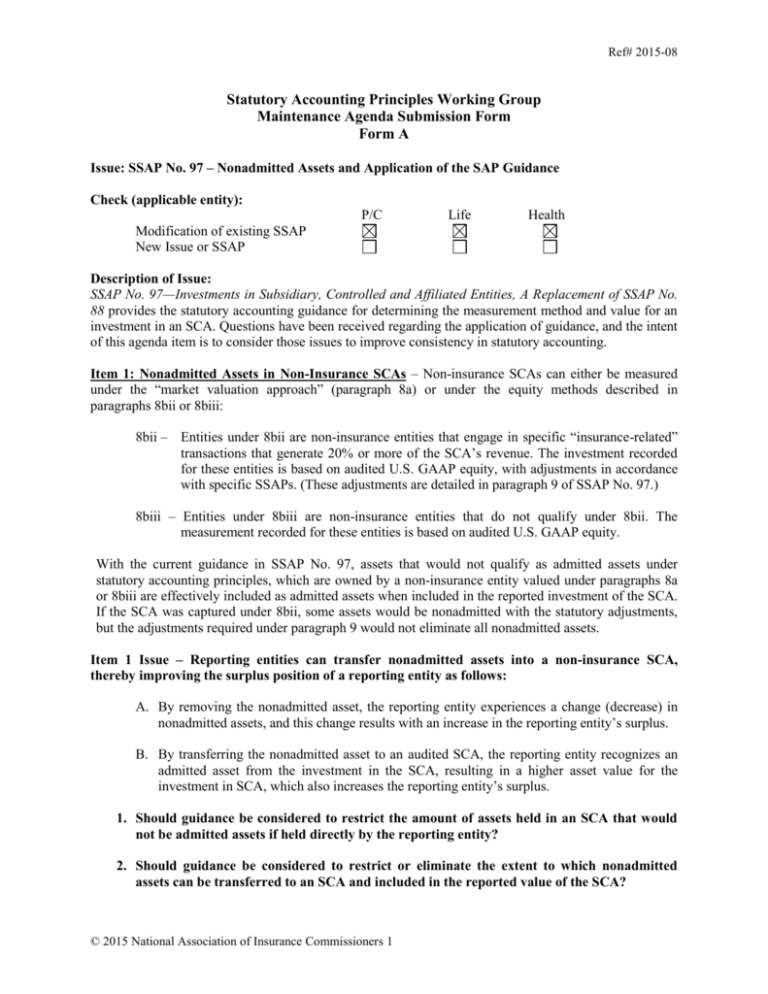
Ref# 2015-08 Statutory Accounting Principles Working Group Maintenance Agenda Submission Form Form A Issue: SSAP No. 97 – Nonadmitted Assets and Application of the SAP Guidance Check (applicable entity): P/C Life Health Modification of existing SSAP New Issue or SSAP Description of Issue: SSAP No. 97—Investments in Subsidiary, Controlled and Affiliated Entities, A Replacement of SSAP No. 88 provides the statutory accounting guidance for determining the measurement method and value for an investment in an SCA. Questions have been received regarding the application of guidance, and the intent of this agenda item is to consider those issues to improve consistency in statutory accounting. Item 1: Nonadmitted Assets in Non-Insurance SCAs – Non-insurance SCAs can either be measured under the “market valuation approach” (paragraph 8a) or under the equity methods described in paragraphs 8bii or 8biii: 8bii – Entities under 8bii are non-insurance entities that engage in specific “insurance-related” transactions that generate 20% or more of the SCA’s revenue. The investment recorded for these entities is based on audited U.S. GAAP equity, with adjustments in accordance with specific SSAPs. (These adjustments are detailed in paragraph 9 of SSAP No. 97.) 8biii – Entities under 8biii are non-insurance entities that do not qualify under 8bii. The measurement recorded for these entities is based on audited U.S. GAAP equity. With the current guidance in SSAP No. 97, assets that would not qualify as admitted assets under statutory accounting principles, which are owned by a non-insurance entity valued under paragraphs 8a or 8biii are effectively included as admitted assets when included in the reported investment of the SCA. If the SCA was captured under 8bii, some assets would be nonadmitted with the statutory adjustments, but the adjustments required under paragraph 9 would not eliminate all nonadmitted assets. Item 1 Issue – Reporting entities can transfer nonadmitted assets into a non-insurance SCA, thereby improving the surplus position of a reporting entity as follows: A. By removing the nonadmitted asset, the reporting entity experiences a change (decrease) in nonadmitted assets, and this change results with an increase in the reporting entity’s surplus. B. By transferring the nonadmitted asset to an audited SCA, the reporting entity recognizes an admitted asset from the investment in the SCA, resulting in a higher asset value for the investment in SCA, which also increases the reporting entity’s surplus. 1. Should guidance be considered to restrict the amount of assets held in an SCA that would not be admitted assets if held directly by the reporting entity? 2. Should guidance be considered to restrict or eliminate the extent to which nonadmitted assets can be transferred to an SCA and included in the reported value of the SCA? © 2015 National Association of Insurance Commissioners 1 Ref# 2015-08 Guidance currently exists in SSAP No. 25—Accounting for and Disclosures with Affiliates and Other Related Parties (SSAP No. 25) paragraph 16d that specifies “Transactions which are designed to avoid statutory accounting practices shall be reported as if the reporting entity continued to own the assets or to be obligated for the liability directly instead of through a subsidiary.” However, with the specific guidance in SSAP No. 97 for the GAAP equity or market valuation method based on the classification of the SCA, it is not believed that this guidance is widely enforced with SCA transactions. Item 2: Valuation of U.S. Insurance SCAs (8bi) – The guidance in paragraph 8bi of SSAP No. 97 requires that U.S. Insurance SCAs be recorded based on the underlying audited statutory equity of the respective entity’s financial statements, adjusted for any amortized goodwill. Reporting entities are to record their investment in the U.S. Insurance SCA on at least a quarterly basis, and shall base the investment value on the most recent quarterly information available from the SCA. Issue – The statutory equity reported by the SCA may be impacted by permitted or prescribed practices, and this impact is not detailed when the reporting entity recognizes their investment in the SCA. There is a presumption that the statutory equity in the U.S. insurance SCA would be in compliance with the statutory accounting principles detailed in the NAIC Accounting Practices and Procedures Manual, with the additional adjustment for unamortized goodwill. However, as 8bi entities that file statutory financial statements, these U.S. insurance entities could have permitted or prescribed practices impacting their statutory equity. As these permitted or prescribed practices are reflected in the SCA’s statutory financial statements, by requiring the investment in the SCA to be calculated by the “audited statutory equity of the SCA’s financial statements” the amount reported would include the impact of any SCA permitted or prescribed practices. Additionally, there is no disclosure required by the reporting entity to identify whether the reported statutory value reflects statutory value under the AP&P Manual, or whether it includes permitted or prescribed practices. Item 2 Discussion Options: 1. Should guidance be considered to require that the value reported for investments in U.S. insurance SCAs reflect statutory value as calculated per the AP&P Manual, and not the statutory value from the SCA’s financial statements, which would include deviations from SAP through prescribed or permitted practices? 2. Should guidance be considered to require that the value reported for investments in U.S. insurance SCAs be the calculated statutory value per the AP&P Manual, with allowances for prescribed practices only, with disclosure required in the reporting entity’s financial statements regarding the SCA’s prescribed deviations from SAP? 3. Should guidance be considered to allow the value reported for investments in U.S. insurance SCAs to be the statutory value as reported on the SCA’s statutory financial statements (current guidance) with disclosure required in the reporting entity’s financial statements regarding the SCA’s prescribed and permitted practices that deviate from SAP? The statutory statements of the SCA should have the detail for prescribed and permitted practices, so the info needed for a disclosure by the reporting entity (parent) should be readily available. Item 3: Valuation of Non-Insurance SCAs Engaging in Insurance Activities (8bii) and Foreign Insurance Entities (8biv) – Non-insurance SCAs that meet the activity and revenue test of paragraph 8bii and foreign insurance SCAs captured within 8biv are to be reported based on the underlying U.S. © 2015 National Association of Insurance Commissioners 2 Ref# 2015-08 GAAP equity (or foreign statutory basis) adjusted to a “statutory basis of accounting” in accordance with the adjustments specifically included in paragraph 9. Issue – The adjustments required in paragraph 9 detail specific changes required to determine the value of the SCAs captured under paragraphs 8bii and 8biv. However, as these are only adjustments for specific items within certain SSAPs, the adjustments do not result in a value that reflects a “statutory basis of accounting” for the SCA. Furthermore, some of the adjustments do not appear consistent with current statutory accounting guidance (e.g., adjustment for DTAs). Item 3 Discussion Options: 1. Should the guidance be revised to clarify that the SCA entities captured within 8bii and 8biv be adjusted to a “full statutory accounting basis”? (With this option, it would be proposed that the specific adjustments in SSAP No. 9 be removed, with an overall reference to make adjustments to comply with the AP&P Manual.) 2. Should the guidance be revised to clarify that the SCA entities captured within 8bii and 8biv do not reflect a “statutory basis of accounting” but rather reflect a value determined after applying limited adjustments per paragraph 9 to their underlying U.S. GAAP or foreign statutory financial statements? 3. If option 2 is pursued, should the guidance in paragraph 9 be updated to reflect more SAP adjustments, or be updated to reflect changes in SSAPs? For example, paragraph 9e requires an adjustment to nonadmit the net DTA of the SCA in excess of 10% of the audited US GAAP equity. This 10% threshold was included in SSAP No. 10, but this guidance was superseded by SSAP No. 101, which has a more detailed admittance calculation. Additionally, most SSAPs identify situations that can generate nonadmitted assets (e.g., if criteria of the SSAP are not met). The adjustments required in paragraph 9a only include five SSAPs. Should more SSAPs be added to this listing to ensure adjustments for nonadmitted assets? Since the guidance in paragraph 8bii and 8biv requires an “adjustment” to the underlying U.S. GAAP, if an adjustment detailed in paragraph 9 is not made, it would be considered a deviation from statutory accounting principles by the reporting entity (not the SCA) and would be required to be disclosed in Note 1 of the reporting entity’s financial statements. Existing Authoritative Literature: SSAP No. 97—Investments in Subsidiary, Controlled or Affiliated Entities (SSAP No. 97) provides the statutory accounting guidance for SCA entities. This statement adopts/rejects a variety of GAAP guidance, but only the following items are included as relevant to this particular agenda item: SSAP No. 97 explicitly adopts the Purposes and Procedures Manual of the NAIC Investment Analysis Office (paragraph 42) SSAP No. 97 rejects APB Opinion 18, The Equity Method of Accounting for Investments in Common Stock © 2015 National Association of Insurance Commissioners 3 Ref# 2015-08 Relevant Excerpts from SSAP No. 97 (paragraphs 8 & 9): Applying the Market Valuation, Audited Statutory Equity and Audited GAAP Equity Methods 8. The admitted investments in SCA entities shall be valued using either the market valuation approach (as described in paragraph 8.a.), or one of the equity methods (as described in paragraph 8.b.). a. b. In order to use the market valuation approach for SCA entities, the following requirements apply: i. The subsidiary must be traded on one of the following major exchanges: (1) the New York Stock Exchange, (2) the American Stock Exchange, (3) the NASDAQ National exchange, or (4) the Tokyo Stock Exchange; ii. The reporting entity must submit subsidiary information to the Securities Valuation Office (SVO) for its calculation of the subsidiary’s market value. Such calculation could result in further discounts in market value above the established base discounts based on ownership percentages detailed below; iii. Ownership percentages for determining the discount rate shall be measured at the holding company level; iv. If an investment in a SCA results in an ownership percentage between 10% and 50%, a base discount percentage between 0% and 20% on a sliding scale basis is required; v. If an investment in a SCA results in an ownership percentage greater than 50% up to and including 80%, a base discount percentage between 20% and 30% on a sliding scale basis is required; vi. If an investment in a SCA results in an ownership percentage greater than 80% up to and including 85%, a minimum base discount percentage of 30% is required. vii. Further, the SCA must have at least two million shares outstanding, with a total market value of at least $50 million in the public’s control; and viii. Any ownership percentages exceeding 85% will result in the SCA being recorded on an equity method. If a SCA investment does not meet the requirements for the market valuation approach in paragraph 8.a. or, if the requirements are met, but a reporting entity elects not to use that approach, the reporting entity’s proportionate share of its investments in SCAs shall be recorded as follows: i. Investments in U.S. insurance SCA entities shall be recorded based on the underlying audited statutory equity of the respective entity’s financial statements, adjusted for any unamortized goodwill as provided for in SSAP No. 68—Business Combinations and Goodwill (SSAP No. 68). Reporting entities shall record investments in U.S. insurance SCA entities on at least a quarterly basis, and shall base the investment value on the most recent quarterly information available from the SCA. Entities may recognize their investment in U.S. insurance SCA entities based on the unaudited statutory equity in the SCAs year-end Annual Statement if © 2015 National Association of Insurance Commissioners 4 Ref# 2015-08 the annual SCA audited financial statements are not complete as of the filing deadline. The recorded statutory equity shall be adjusted for audit adjustments, if any, as soon as the annual audited financial statements have been completed. Annual consolidated or combined audits are allowed if completed in accordance with the Model Regulation Requiring Annual Audited Financial Reports as adopted by the SCA’s domiciliary state; ii. Investments in both U.S. and foreign noninsurance SCA entities that are engaged in the following transactions or activities: (a) Collection of balances as described in SSAP No. 6—Uncollected Premium Balances, Bills Receivable for Premiums, and Amounts Due From Agents and Brokers (b) Sale/lease or rental of EDP Equipment and Software as described in SSAP No. 16R—Electronic Data Processing Equipment and Accounting for Software (c) Sale/lease or rental of furniture, fixtures, equipment or leasehold improvements as described in SSAP No. 19—Furniture, Fixtures and Equipment; Leasehold Improvements Paid by the Reporting Entity as Lessee; Depreciation of Property and Amortization of Leasehold Improvements (d) Loans to employees, agents, brokers, representatives of the reporting entity or SCA as described in SSAP No. 20— Nonadmitted Assets (e) Sale/lease or rental of automobiles, airplanes and other vehicles as described in SSAP No. 20—Nonadmitted Assets (f) Providing insurance services on behalf of the reporting entity including but not limited to accounting, actuarial, auditing, data processing, underwriting, collection of premiums, payment of claims and benefits, policyowner services (g) Acting as an insurance or administrative agent or an agent for a government instrumentality performing an insurance function (e.g. processing of state workers compensations plans, managing assigned risk plans, Medicaid processing etc). (h) Purchase or securitization of acquisition costs and if 20% or more of the SCA’s revenue is generated from the reporting entity and its affiliates, then the underlying equity of the respective entity’s audited U.S. Generally Accepted Accounting Principles (GAAP) financial statements shall be adjusted to a statutory basis of accounting in accordance with paragraph 9. For purposes of this section, revenue means GAAP revenue reported in the audited U.S. GAAP financial statements excluding realized and unrealized capital gains/losses. Foreign SCA entities are defined as those entities incorporated or otherwise legally formed under the laws of a foreign country. Paragraphs 21-26 provide guidance for investments in holding companies; © 2015 National Association of Insurance Commissioners 5 Ref# 2015-08 c. iii. Investments in both U.S. and foreign noninsurance SCA entities that do not qualify under paragraph 8.b.ii., shall be recorded based on the audited U.S. GAAP equity of the investee. Foreign SCA entities are defined as those entities incorporated or otherwise legally formed under the laws of a foreign country. Additional guidance on investments in downstream holding companies is included in paragraphs 21-26. Additional guidance on the use of audited foreign GAAP basis financial statements for the U.S. GAAP equity valuation amount is included in paragraph 22.b. iv. Investments in foreign insurance SCA entities shall be recorded based on the underlying U.S. GAAP equity from the audited U.S. GAAP basis financial statements, if available, or the audited foreign statutory basis financial statements of the respective entity adjusted to a statutory basis of accounting in accordance with paragraph 9 and adjusted for reserves of the foreign insurance SCA with respect to the business it assumes directly and indirectly from a U.S. insurer using the statutory accounting principles promulgated by the NAIC in the Accounting Practices and Procedures Manual. The audited foreign statutory basis financial statements must include an audited footnote that reconciles net income and equity on the foreign statutory basis of accounting to the U.S. GAAP basis. Foreign insurance SCA entities are defined as alien insurers formed according to the legal requirements of a foreign country. The following provides guidance regarding the audits for entities covered under paragraph 8.b.: i. The recorded GAAP equity shall be adjusted for any audit adjustments resulting from either the annual audited GAAP financial statements of the respective entity or, if the entity is a member of a consolidated or combined group of insurers, the annual audited GAAP financial statements of the consolidated or combined group of companies, as soon as determined. GAAP is defined as those pronouncements included in the FASB codification. ii. Annual consolidated or combined audits are allowed for the valuation of U.S. insurance entities if completed in accordance with the Model Regulation Requiring Annual Audited Reports as adopted by the SCA’s domiciliary state. iii. Consolidated or combined financial statements are allowed for the valuation of downstream SCA entities, including downstream SCA entities, that directly or indirectly own U.S. insurance entities, provided that the statutory financial statements of such U.S. insurance entities are audited. The audited financial statements of the downstream SCA entities shall include, as other financial information, consolidating or combining balance sheet schedule(s) showing the equity of all relevant SCA entities, non SCA SSAP No. 48 entities, and any required intercompany eliminations. The consolidating or combining balance sheet of the downstream SCA entities shall then be adjusted for GAAP to SAP differences of the insurance entities and paragraph 8.b.ii. and 8.b.iv. entities owned directly and indirectly by the downstream SCA entities. iv. Investments in foreign SCA entities shall follow the guidance in paragraphs 8.b.ii., 8.b.iii. and 8.b.iv. based upon the nature of the SCA as described in the respective paragraphs. To fulfill the requirement for © 2015 National Association of Insurance Commissioners 6 Ref# 2015-08 audited U.S. GAAP basis financial statements, the value of foreign SCA investments may be based on the GAAP equity from audited financial statements prepared on a foreign GAAP basis. The audited foreign GAAP basis financial statements must include an audited footnote that reconciles net income and equity on the foreign GAAP basis of accounting to the U.S. GAAP basis. The statutory carrying value of foreign insurance SCA entities (i.e., 8.b.iv. entities) and foreign noninsurance 8.b.ii. SCA entities shall include the additional adjustments as described in paragraph 9. 9. The statutory basis of accounting for investments in noninsurance SCA entities, subject to paragraph 8.b.ii. and foreign insurance SCA entities, subject to paragraph 8.b.iv., shall be based on the underlying audited U.S. GAAP equity of the respective entity with the following adjustments: a. Nonadmit assets pursuant to the following statutory accounting principles as promulgated by the NAIC in the Accounting Practices and Procedures Manual; i. SSAP No. 6—Uncollected Premium Balances, Bills Receivable for Premiums, and Amounts Due From Agents and Brokers ii. SSAP No. 16R—Electronic Data Processing Equipment and Accounting for Software iii. SSAP No. 19—Furniture, Fixtures and Equipment; Leasehold Improvements Paid by the Reporting Entity as Lessee; Depreciation of Property and Amortization of Leasehold Improvements iv. SSAP No. 20—Nonadmitted Assets v. SSAP No. 29—Prepaid Expenses b. Expense costs that are capitalized in accordance with GAAP but are expensed pursuant to statutory accounting as promulgated by the NAIC in the Accounting Practices and Procedures Manual (e.g., deferred policy acquisition costs); c. Adjust depreciation for certain assets in accordance with the following statutory accounting principles: i. SSAP No. 16R—Electronic Data Processing Equipment and Accounting for Software ii. SSAP No. 19—Furniture, Fixtures and Equipment; Leasehold Improvements Paid by the Reporting Entity as Lessee; Depreciation of Property and Amortization of Leasehold Improvements d. Nonadmit the amount of goodwill of the SCA in excess of 10% of the audited U.S. GAAP equity of the SCA’s last audited financial statements. e. Nonadmit amount of the net deferred tax assets (DTAs) of the SCA in excess of 10% of the audited U.S. GAAP equity of the SCA’s last audited financial statements. f. Adjust the U.S. GAAP annuity account value reserves of a foreign insurance SCA, with respect to the business it wrote directly, using the commissioners' annuity reserve valuation method (CARVM) as defined in paragraphs 12 and 13 © 2015 National Association of Insurance Commissioners 7 Ref# 2015-08 of Appendix A-820 (including the reserving provisions in the various Actuarial Guidelines which support CARVM). The valuation interest rate and mortality tables to be used in applying CARVM should be that prescribed by the foreign insurance SCA's country of domicile. If the Foreign SCA’s country of domicile does not prescribe the necessary tables and/or rates, no reserve adjustment shall be made. Note that the outcome of these adjustments, as well as guarantees or commitments of the parent entity to provide additional funding, can result in a negative equity valuation of the investment. The section from the P&P Manual on the Valuation of SCAs is included in Exhibit A Activity to Date (issues previously addressed by SAPWG, Emerging Accounting Issues WG, SEC, FASB, other State Departments of Insurance or other NAIC groups): None Information or issues (included in Description of Issue) not previously contemplated by the SAPWG: None Staff Recommendation: It is staff’s recommendation that the Working Group initially move this to the substantive active listing, with a request for comments from regulators and industry on the specific issues noted in the discussion (and duplicated below). Depending on the responses received, the Working Group will assess the extent of revisions necessary and may reconsider whether this is a substantive or nonsubstantive issue. Comments are Requested on the Following Issues and Discussion Items: Item 1: Nonadmitted Assets in Non-Insurance SCAs Reporting entities can transfer nonadmitted assets into a non-insurance SCA, thereby improving the surplus position of a reporting entity. 1. Should guidance be considered to restrict the amount of assets held in an SCA that would not be admitted assets if held directly by the reporting entity? 2. Should guidance be considered to restrict or eliminate the extent to which nonadmitted assets can be transferred to an SCA and included in the reported value of the SCA? Item 2: Valuation of U.S. Insurance SCAs (8bi) The statutory equity reported by the insurance SCA may be impacted by permitted or prescribed practices, and this impact is not detailed within the reporting entity’s (parent) financial statements. 1. Should guidance be considered to require that the value reported for investments in U.S. insurance SCAs reflect statutory value as calculated per the AP&P Manual, and not the statutory value from the SCA’s financial statements, which would include deviations from SAP through prescribed or permitted practices? 2. Should guidance be considered to require that the value reported for investments in U.S. insurance SCAs be the calculated statutory value per the AP&P Manual, with allowances for prescribed practices only, with disclosure required in the reporting entity’s financial statements regarding the SCA’s prescribed deviations from SAP? © 2015 National Association of Insurance Commissioners 8 Ref# 2015-08 3. Should guidance be considered to allow the value reported for investments in U.S. insurance SCAs to be the statutory value as reported on the SCA’s statutory financial statements (current guidance) with disclosure required in the reporting entity’s financial statements regarding the SCA’s prescribed and permitted practices that deviate from SAP? Item 3: Valuation of Non-Insurance SCAs Engaging in Insurance Activities (8bii) and Foreign Insurance Entities (8biv) The adjustments required in paragraph 9 detail specific changes required to determine the value of the SCAs captured under paragraphs 8bii and 8biv. However, as these are only adjustments for specific items within certain SSAPs, the adjustments do not result in a value that reflects a “statutory basis of accounting” for the SCA. Furthermore, some of the adjustments do not appear consistent with current statutory accounting guidance (e.g., adjustment for DTAs). 1. Should the guidance be revised to clarify that the SCA entities captured within 8bii and 8biv be adjusted to a “full statutory accounting basis”? (With this option, it would be proposed that the specific adjustments in SSAP No. 9 be removed, with an overall reference to make adjustments to comply with the AP&P Manual.) 2. Should the guidance be revised to clarify that the SCA entities captured within 8bii and 8biv do not reflect a “statutory basis of accounting” but rather reflect a value determined after applying limited adjustments per paragraph 9 to their underlying U.S. GAAP or foreign statutory financial statements? 3. If option 2 is pursued, should the guidance in paragraph 9 be updated to reflect more SAP adjustments, or be updated to reflect changes in SSAPs? For example, paragraph 9e requires an adjustment to nonadmit the net DTA of the SCA in excess of 10% of the audited US GAAP equity. This 10% threshold was included in SSAP No. 10, but this guidance was superseded by SSAP No. 101, which has a more detailed admittance calculation. Additionally, most SSAPs identify situations that can generate nonadmitted assets (e.g., if criteria of the SSAP are not met). The adjustments required in paragraph 9a only include five SSAPs. Should more SSAPs be added to this listing to ensure adjustments for nonadmitted assets? Staff Review Completed by: Julie Gann– February 10, 2015 Status: On March 28, 2015, the Statutory Accounting Principles (E) Working Group moved this item to the substantive active listing and exposed this agenda item requesting comments on the issues and discussion questions regarding the reporting of investments in SCAs under SSAP No. 97. G:\DATA\Stat Acctg\3. National Meetings\A. National Meeting Materials\2015\Spring\NM Exposures\15-08 - SSAP No. 97 Questions.doc © 2015 National Association of Insurance Commissioners 9


